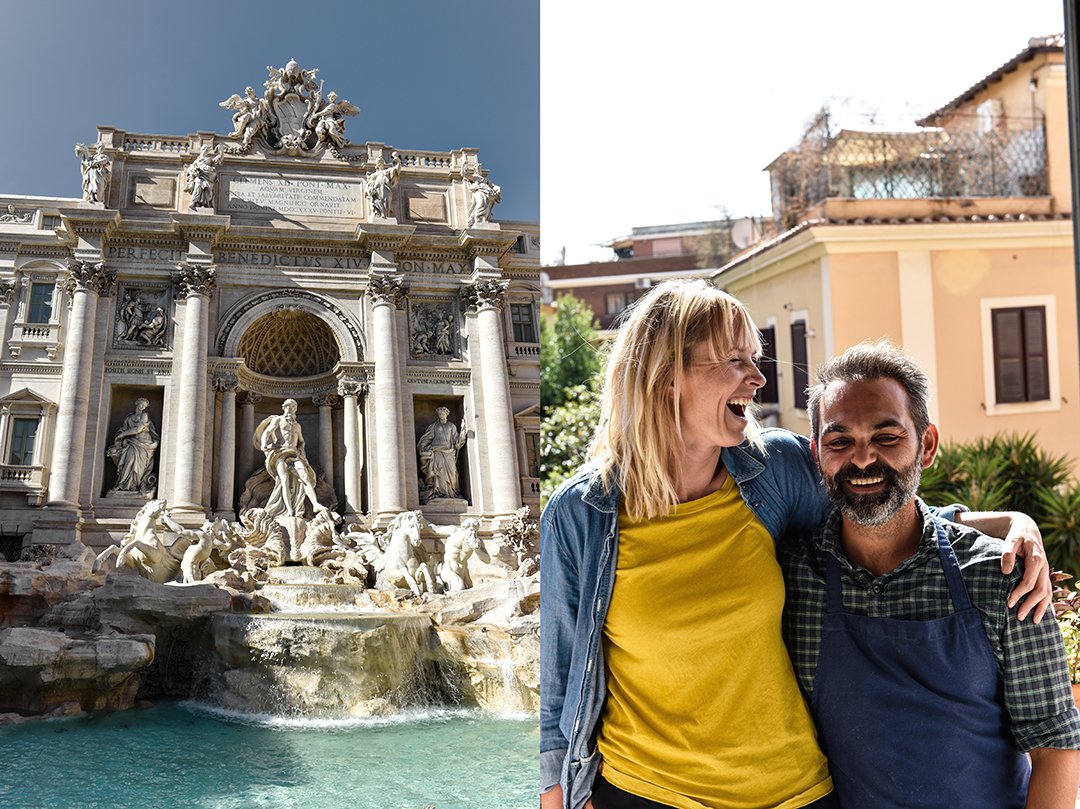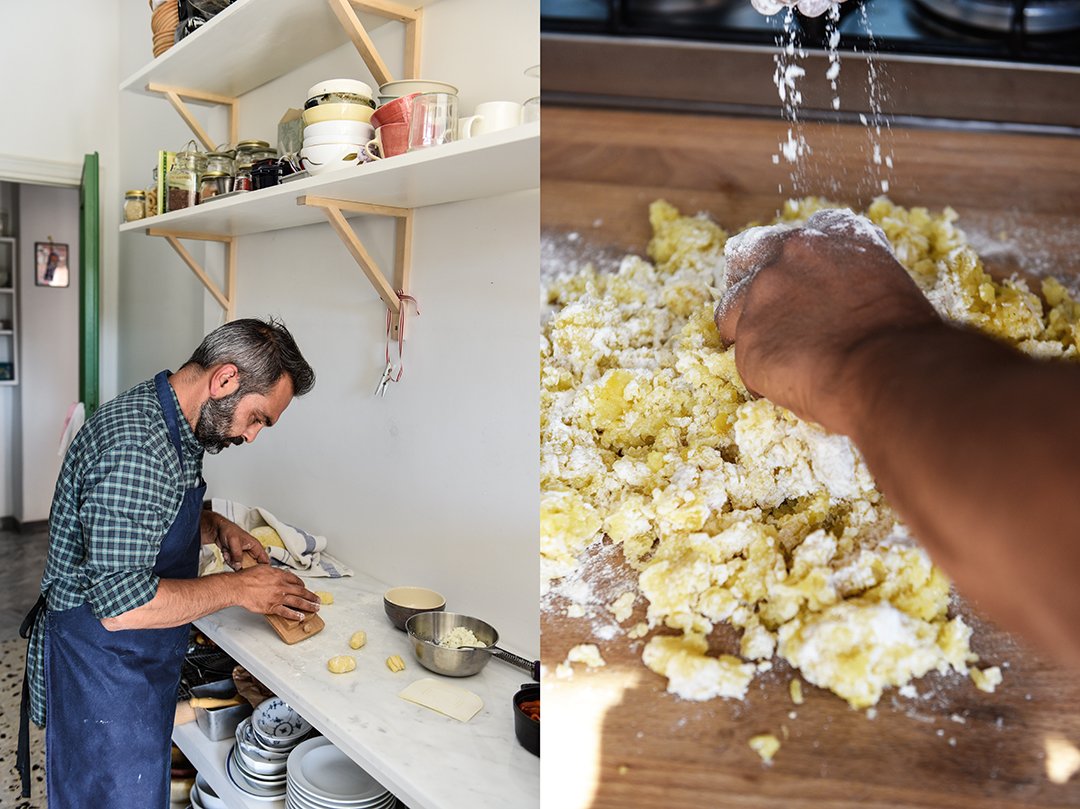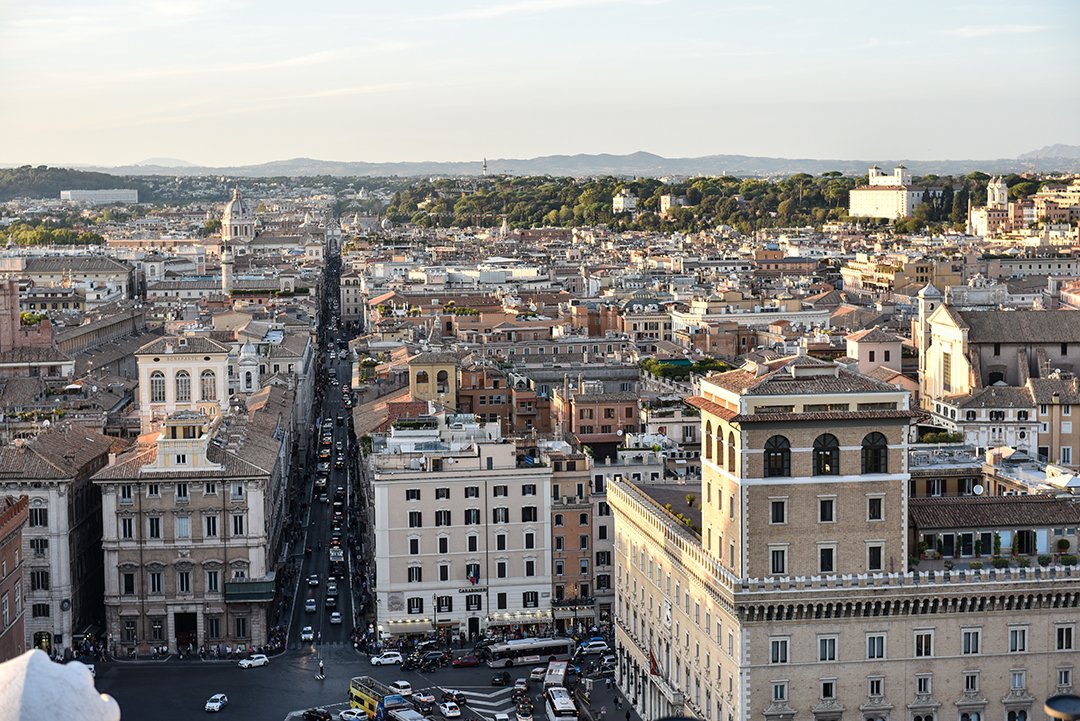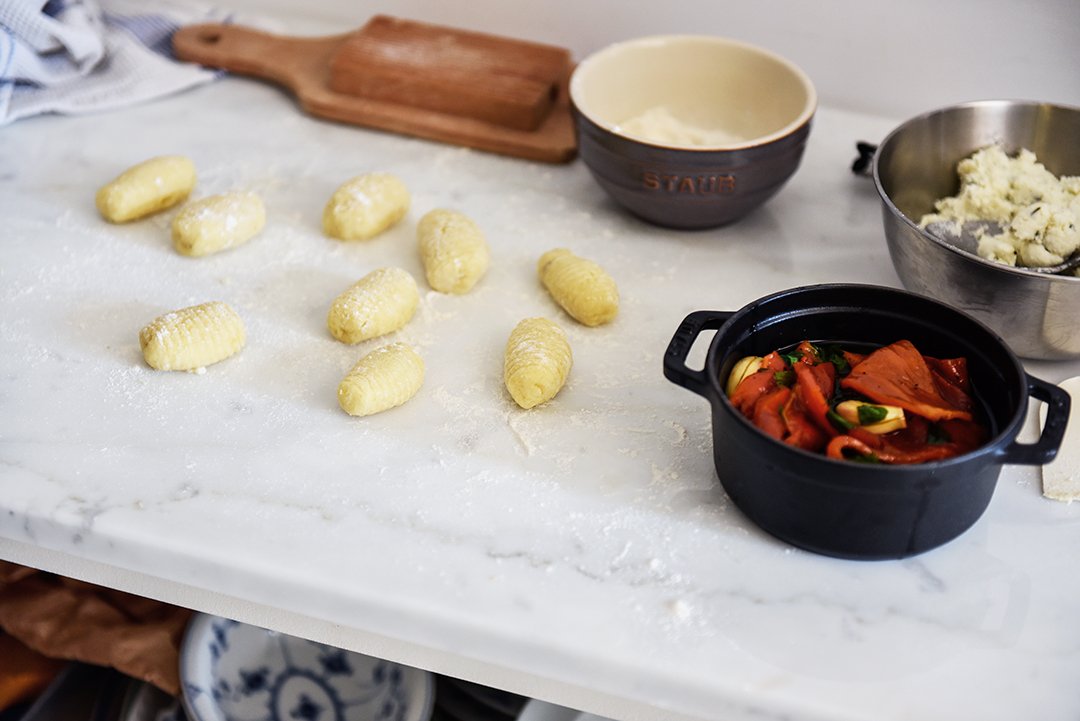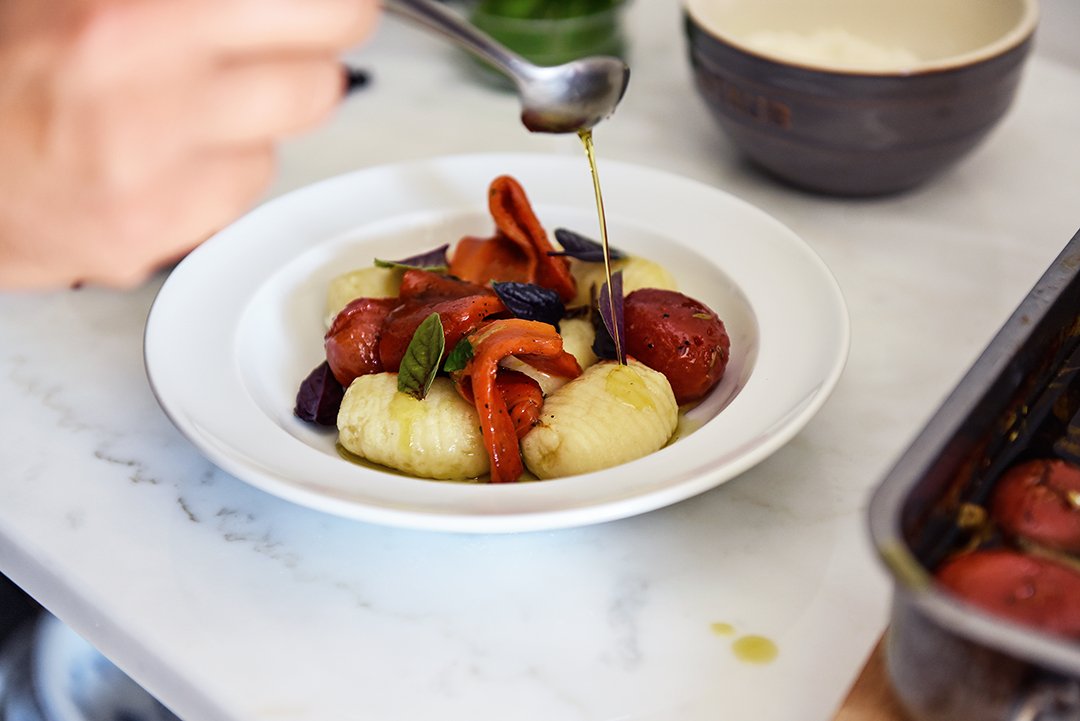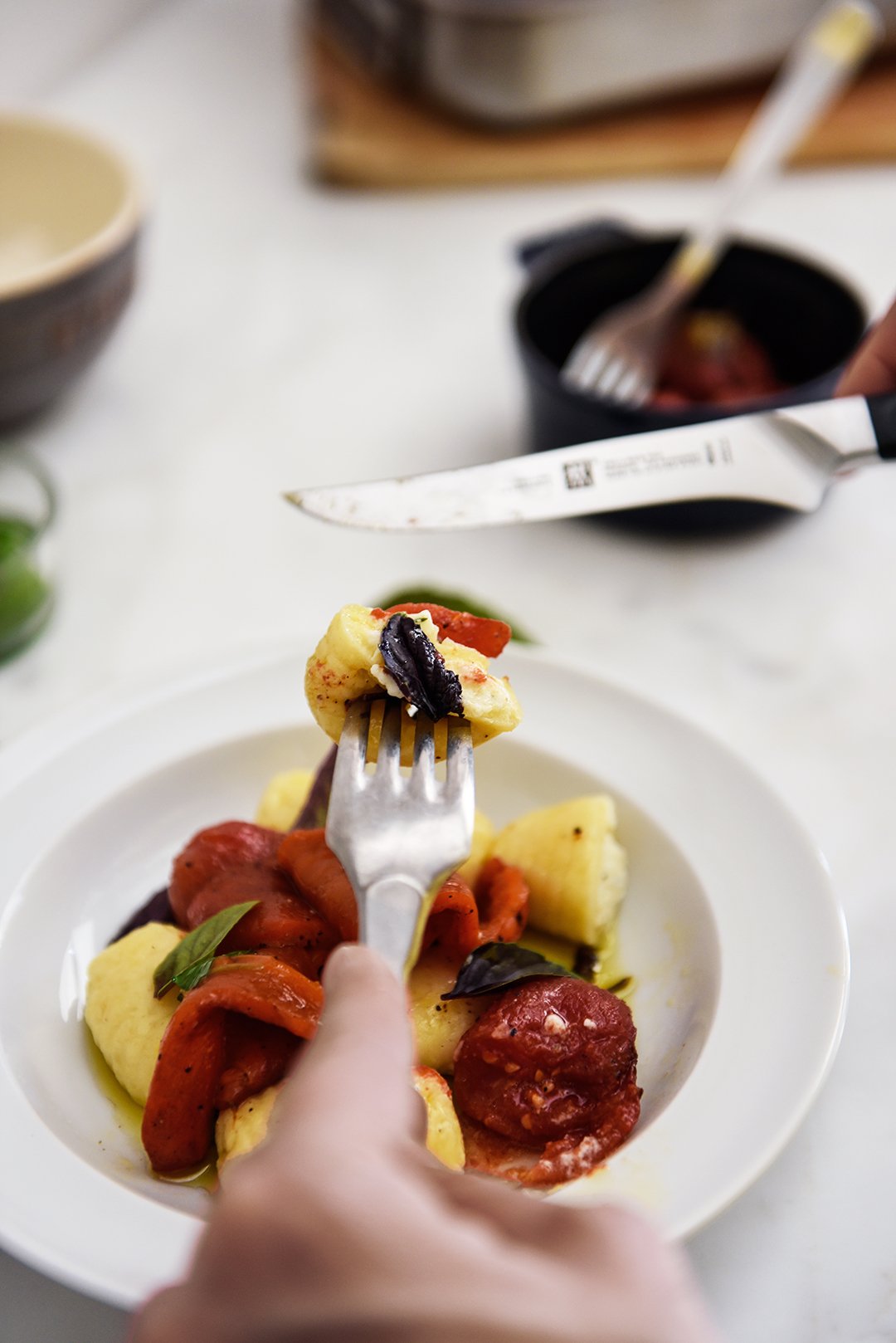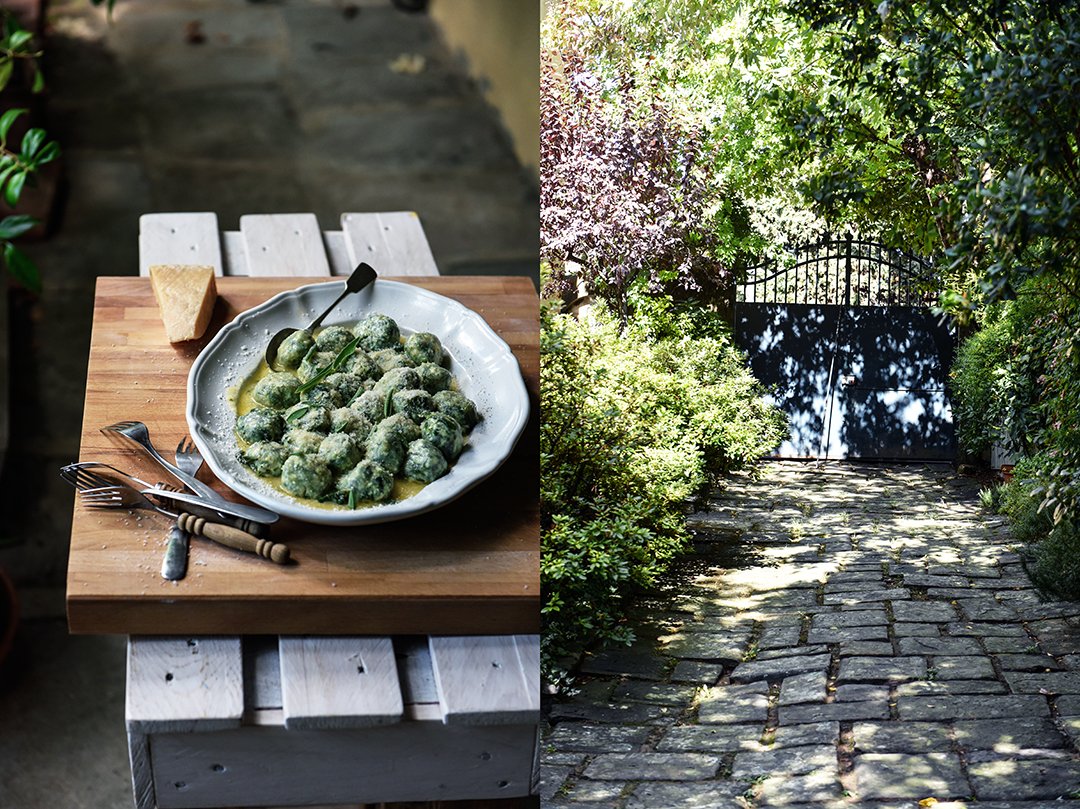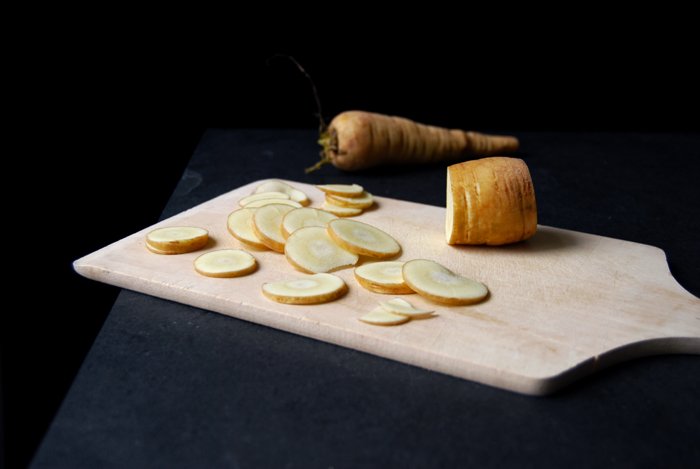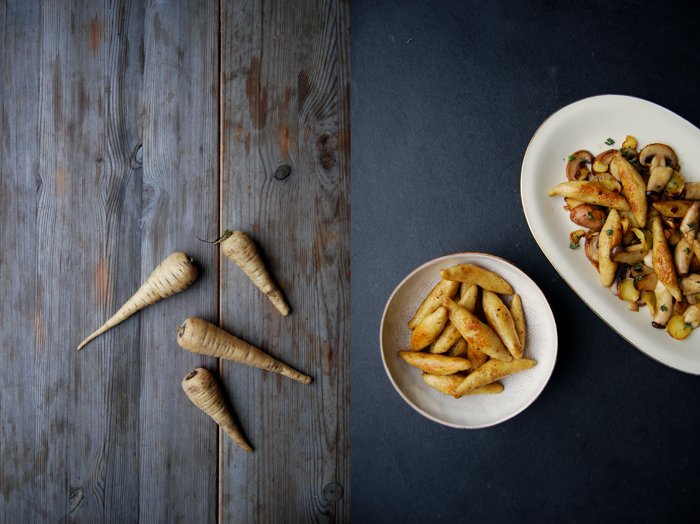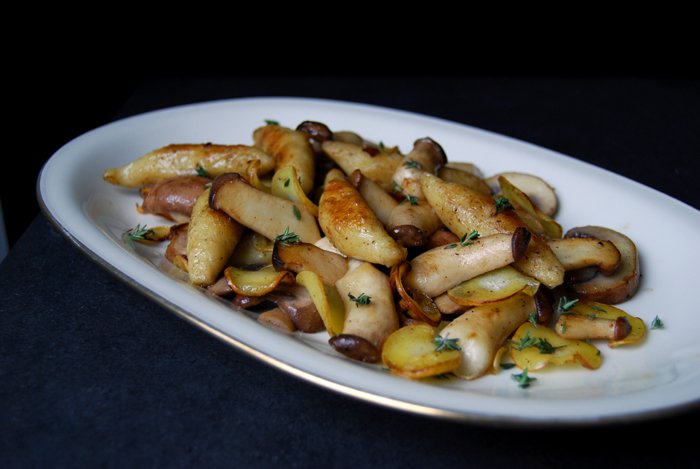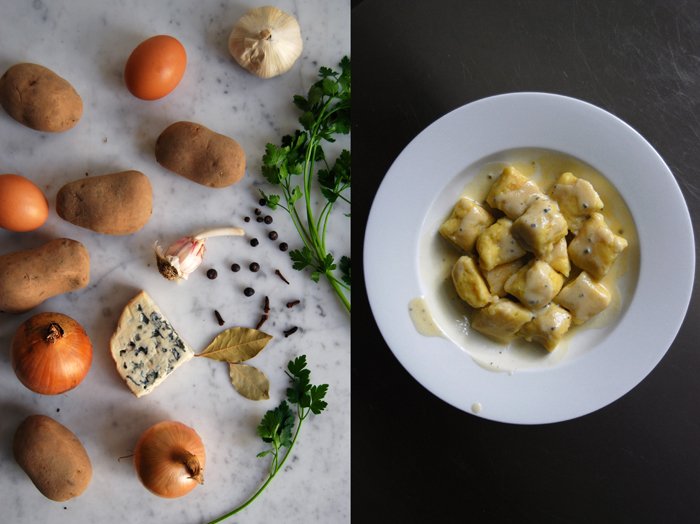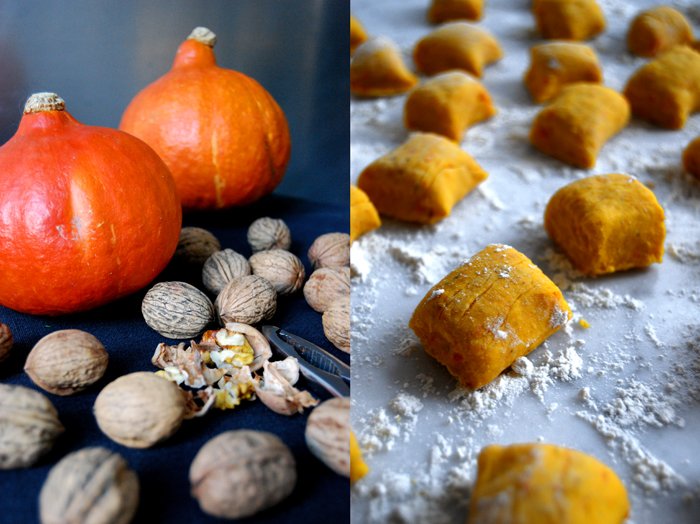Meet In Your Kitchen | Love, Rome & Gnocchi
Imagine your friends throw an opulent dinner party in the pulsing heart of Rome on a Saturday night und you take over their kitchen hours before the guests arrive with a film team of four to peek over your hosts' shoulders into their pots and pans. Sofie Wochner and Domenico Cortese dealt with our little invasion with remarkable patience. They even welcomed us with big smiles on their faces and a plate full of fresh buttery Danish cinnamon buns in their hands.
The passionate couple is a confident team in the kitchen, they complement each other and combine two worlds that are geographically and culturally far apart, but somehow match smoothly. Sofie is a Danish baker and pastry chef with the impulsive temper of an Italian Signorina, self-taught Chef Domenico comes from Calabria, from the southern tip of Italy, but totally lacks the Mediterranean drama that one would expect. His voice is calm and his movements are concentrated, he's quiet and focused when he works in the kitchen. He says he was born in the wrong country, he feels much closer to the northern European mentality, whereas his woman only feels as free and inspired as she wants to be when she's in her adopted city, in Rome.
A city kitchen is often a space of improvisation and elaborate compromises, the smallest but also the most charming room of an apartment. It's the place where everybody meets at a party, making use of every square inch, squeezed and snuggled in, the happy crowd talks, eats, and drinks until dawn. Our hosts' kitchen is just such a magical place, but it's also a room where the two chefs manage to create the most wonderful dishes for private gatherings, catering, and highly anticipated supper clubs. When it's time to open the doors for their Eatery In Rome pop-up restaurant in their flat's dining room, the kitchen turns into a busy laboratory functioning like clockwork. Loaves of bread and cakes baking in batches in the single oven, pillowy gnocchi rolled and shaped on the wooden board at the window, and bell peppers roasting in the flames of the old gas cooker. The room is bright, facing the pretty balcony, Domenico's beautiful little herb garden where basil, thyme, and rosemary grow happily under Rome's ever shining sun - all waiting to be used in the masters' glorious recipes, like their Stuffed Gnocchi with Mozzarella di Bufala, Confit Tomatoes and Flame-roasted Bell Peppers (you can find the recipe below). The potato gnocchi melt in your mouth like fluffy clouds, the creamy filling makes it smooth and fits perfectly to the candy-like tomatoes and smoky peppers. It's a delicious stunner, a colorful homage to the beauty of Italian cuisine.
In the past few months, the busy duo made their dream come true and started working on their new baby: Marigold. If you would like to support Sofie and Domenico and help them fund their new restaurant and micro bakery in the Roman neighborhood Ostiense, click here.
Many new Meet In Your Kitchen features took me to California, Japan, France, and Italy in the last few months. Thanks to Zwilling for sponsoring these features for our culinary trip around the world!
Mozzarella di Buffala stuffed Gnocchi with Confit Tomatoes and Flame-roasted Bell Pepper
By Domenico Cortese & Sofie Wochner – Marigold, Rome
You can find the German recipe here.Prepare the confit tomatoes and roasted bell pepper a day in advance.Serves 4
Flame-roasted Bell Pepper
1 large red bell pepper
3 cloves of garlic, crushed
1/2 medium bunch of parsley, leaves only, chopped
Fine sea salt
Ground black pepper
About 150ml / 2/3 cup olive oil
You can either grill peppers in the flames of a gas cooker (that's what Domenico does) or grill or roast them in the oven (on the highest temperature, turning them every few minutes until partly black), which is the safer method.
Place the pepper on the gas flame of your cooker set on medium heat. Turn the pepper every now and then, mind that the skin turns dark and forms blisters evenly on all sides. Transfer the hot pepper to a bowl and cover with cling film, let it sit for 15 minutes. Use a small, sharp knife to peel the pepper, cut it in half, and scrape out and discard any seeds and fibers. Cut into strips and transfer to a bowl. Add the garlic, parsley, salt, and pepper and cover with the olive oil. Cover the bowl and let it sit for at least a few hours, or over night.
Confit Tomatoes
8 tomatoes, preferably Piccadilly tomatoes
Fine sea salt
Ground black pepper
3 medium sprigs fresh savory
4 medium sprigs fresh thyme
10 medium sprigs fresh basil
3 cloves of garlic, crushed
Olive oil
Bring a medium pot of water to a boil. Fill a large bowl with ice water.Clean and score the skin of the tomatoes. Blanch them for 20 seconds in the boiling water, then transfer to the ice water. Use a small, sharp knife to gently pull off the skin without cutting them. Transfer to a small baking dish, season with salt and pepper, and cover with cling film. Let them rest in the fridge overnight.
Take the tomatoes out of the fridge about 1 hour before roasting them. Preheat the oven to 130°C / 275°F.
Spread the herbs and garlic on top of the tomatoes and cover them completely with olive oil. Roast for about 4 hours or until they are soft.
Gnocchi
For the filling
150g / 5 ounces mozzarella di buffala
50g / 2 ounces Parmesan
3 sprigs fresh basil, leaves only, plus a handful leaves for serving
1/2 tablespoon olive oil
Fine sea salt
Ground black pepper
For the gnocchi
500g / 18 ounces floury potatoes
1 small egg
50g / 2 ounces Parmesan
Fine sea salt
Ground black pepper
Freshly grated nutmeg
100g / 3/4 cup plus 1 tablespoon flour, type 00
For the filling, purée the mozzarella, Parmesan, basil, olive oil, salt, and pepper in a food processor or blender until smooth. Season to taste with salt and pepper and chill in the fridge for 10 minutes.
For the gnocchi, boil the potatoes in unsalted water for about 30-40 minutes or until soft. Drain and let them rest for 10 minutes. Peel the potatoes and press them through a potato ricer onto a large chopping board or kitchen counter, form a little dome. Add the egg, Parmesan, salt, pepper, and nutmeg and, using your hands and a dough scraper, mix everything together. Add the flour in batches and mix quickly until the gnocchi mixture is combined. Add more flour, if it's too sticky; mind not to over mix it.
Form the gnocchi while the mixture is still warm: Cut off a handful of dough, keep the remaining dough covered with a tea towel, and roll it into a 2.5cm / 1 inch-thick roll. Cut into 1cm / 0.5 inch-thick slices. Using 2 fingers, make a dent in the middle of each slice. Add a tablespoon of the filling and close the gnocchi by rolling it in your hands. Transfer the gnocchi to a baking sheet dusted with flour. When all the gnocchi are filled, cook them immediately in salted water (it should taste like the sea) for about 3-4 minutes or until they raise to the surface; or freeze them, but don't keep them in the fridge.
Using a slotted ladle, transfer the gnocchi to the plates. Arrange the confit tomatoes and roasted peppers on top, drizzle with the oil used to roast the tomatoes, and sprinkle with fresh basil.
Buon Appetito!
Can you tell us a little bit about yourself?
Sofie Yes, I’m Danish and I moved to Rome four years ago to live with Domenico. Straight away, we started our little pop up restaurant in our home here in Rome. I make the bread and the pastry. So we divide the work between the two of us.
And you’re the chef, Domenico?
Domenico Si! Our work is completely separate. I’m not so good with pastry because I don’t like to follow the recipe, but I like the freestyle more.
Sofie You’re a creative soul.
Domenico I'm a chef and I don't know how to work with recipes. I need to be creative and use my inspiration – from my work at the American Academy as well as from my Italian background. Now I have arrived at a place in my life where I have really found my own style.
When did you arrive here in Rome?
Domenico It was in January 2000. Before that, I spent 5 years of my life in Holland and I then decided to come back to Rome - especially because part of my family is here.
Where are you from originally?
Domenico I’m originally from Tropea, a small town in Calabria, where I grew up until I was 18.
Sofie, what made you leave Denmark?
Sofie I’ve always been extremely adventurous and I always felt that maybe Denmark, or maybe Copenhagen, was a little bit too small. That the mentality is – without sounding arrogant – but it’s a bit closed and I’m kind of a loud person (laughing)! So I felt coming to Italy, I kind of came home in a way. Here, there is space to be who you are. You don’t need to fit into a little box. But I still love Denmark and Copenhagen and where I grew up. I go back quite often but I really feel at home in Rome.
Domenico Lucky me!
How do you bring your two worlds together, the Danish and the Italian mentality?
Sofie In many ways I’m more Italian than Domenico is. And he’s more Danish than I am in the sense that Domenico is very precise and he’s always on time. Yes, you’re quite organized and structured.
Domenico Honestly, maybe too much sometimes!
Sofie You’re too Danish sometimes (laughing)! In many ways, I’m very attracted to the southern part of Europe because you’re allowed to express your passion and your feelings in a way that comes very natural to me. I feel welcome and I feel very much at ease here. For us, I think we meet in the middle. Of course, it’s not always easy…
Domenico No, not really!
Sofie …being from two different cultures. A relationship is always hard work but in many ways we also find a way to balance it out by being attracted by each other’s cultures. Domenico could easily live in Denmark if that happened one day but I prefer to live here!
Can you tell us a little bit about your supper clubs?
Sofie Yes, it started 3 1/2 years ago now. It came a little bit by coincidence. We both had this dream about opening a restaurant. And you don’t do that overnight. So we thought maybe we could just start at home. How many tables can we fit into the living room?
Domenico Yes, let’s try and see how it will work. Which kind of guests can we get?
Sofie So it started a bit like that and from the beginning it’s been quite successful. It really gave us the possibility to try out our own style…
Domenico ... to show to our guests what we can do.
Sofie Domenico, you could really try to work on your own style and I think you discovered more and more about who you are through your cooking here than you’ve done anywhere else. And it’s fun! It’s fun to play around with so many things and we are still using the best, seasonal, and local produce. We don’t necessarily cook amitriciana – we try to use the products in a new way, but still keeping the roots in the simplicity of the Italian kitchen…
Domenico …the basis is the Italian cuisine but of course we kind of try to change a little bit or invent something new.
Sofie It’s a feast! In our pop-up restaurant at home we have 12 people sitting at a long table, so you’re eating with people you don’t know but who you get to know very quickly. It’s one big dinner party with people you don’t know which is very unusual here. And every dinner and every evening is completely different to the others, but there’s always a good energy.
Domenico Yes, I can hear it from the kitchen!
Sofie People are chatting away…
Domenico …and laughing! It’s nice!
Did you ever have a funny experience?
Sofie We had a very, very romantic experience! We had two guests, they both came here before, and then one evening, they were here at the same time – they didn’t know each other – and they started to chat over the table. So they met and they got together and then they came back with their parents and they’re in a serious relationship. And they keep coming back! I think they’ve been here like four times! So they kind of grew with us. It was a really cute thing and they are such lovely people.
And then one day they will bring their children!
Sofie Exactly (laughing)!
Do you think that the people who come to Rome, the tourists, have a very clear idea of what they expect to eat when they come to this city?
Sofie Yes. I think it’s fair enough because you come to the most ancient city in the world, so of course it’s not vibrant, modern, things are not changing every half year with a new trend. Of course you know what you’re getting. Unfortunately, because there are so many tourists passing through Rome the quality of even these key dishes in the city is just not good enough. They don’t respect people enough here, and they’re not being proud enough about what they do. I think that’s disturbs us sometimes. Who doesn’t love a creamy cacio e pepe? Or a carbonara? But you don’t need to put cream in there! There shouldn’t be cream in there. They don’t expect that the people coming here to visit can actually taste what they eat. That’s a bit of a shame because Rome also doesn’t have the best reputation. In Paris, there has been this small revolution and I think slowly I can see it happening here too. The younger generations are observing that there is something to be done here, that we’re losing something if we don’t respect our traditions more. Even though the traditions are very strong, it’s not expressed in the actual plate in front of you.
Domenico, what is your greatest kitchen hack?
Domenico For the gnocchi, you need to have really good, starchy potatoes. You can choose between two kinds of potatoes, but the trick to make really good gnocchi is to have starchy potatoes!
What about you, Sofie?
Sofie Being a Dane, I have to mention Danish butter because I actually use Danish butter here. Italian butter doesn’t have the right structure. It’s really important when you do pastry that you use the right kind of butter. It doesn’t necessarily need to be organic either. Often, organic butter tends to hold too much water which means your pastry or your cake can become wet in a way – it doesn’t get the right structure. I can only use French butter or Danish butter in my pastry. So, I believe the basic key is to use really, really good butter. And lots of it (laughing)!
If you could choose one person to cook a meal for you, who and what would it be?
Domenico My mom. I have a lot of memories as a child, but I remember I really liked the minestrone. She used to strain everything but it was so good.
Sofie I’m very, very fond of the way Chad Robertson from Tartine Bakery in San Francisco bakes his bread. I even went there to see them bake. But for him to bake a loaf of bread for me, take it out of the oven and serve it to me with Danish butter (laughing), I think I would be in heaven!
Mille grazie, Sofie and Domenico!
Meet In Your Kitchen | Emiko Davies & Marco Lami's Dolce Vita in Florence
Italy is a luscious feast, its abundant beauty captures all your senses. As soon as I cross the border into the boot, I don't even know where to start feeding my cravings, which food I should try first, which wine I should pick to fill my glass. You can't help it, you fall in love with this country, over and over again, every day. And when you leave, you don't know how you should ever put anything else into your mouth than the most perfect Truffle Carbonara from that tiny Trattoria in Orvieto, or the dark Chianti from that dreamy Fattoria enjoying spectacular views over San Gimignano. The kitchens and tables are always filled with the most wonderful treats waiting to be shared, the people have their own pace and a smile for you at any time, the past is treasured yet critically considered and wisely woven into the present.
We arrived in Florence on a cloudy day, the Tuscan hills spread out softly like open arms welcoming us to the next stop of our culinary trip around the world together with Zwilling. Before you even enter the region's capital, before the man-made Renaissance buildings, sculptures, and gardens take your breath away, it's nature's creations, the landscapes that you'll save in your head and never forget. It's a stunning scene, seemingly peaceful in warm, earthy colors, but like a romantic painting, you can feel that there's always the potential for more, a hint of drama in the air. Bright blue skies brushed with pastel-pink strokes are the background for cypress trees swaying silently in the warm wind, the darkest clouds part suddenly and let the sun break through to light up this glorious kingdom.
The farmers markets offer the most colorful produce. Fruits and vegetables grow happily under the Italian sun, and they are proudly celebrated in the country's various regional cuisines. Italian cooking follows one philosophy: use only the best products, don't distract from their quality, and be guided by sensible simplicity. Especially in the countryside, you can feel a lot of respect for nature and the will to go back to a more natural and sustainable way of growing produce and raising animals. The younger generation takes a look into the past to learn from the precious heritage of their ancestors. Traditional recipes are being modified yet never erased from the menu, they have always been an important part of the culture, they are memories of the childhood of every Italian and special treats for the rest of the world.
Somewhere in the soft hills behind Florence, between olive groves and cypress trees growing tall into the sky, you can find a heavy iron gate framed by a washed out yellow wall. If you walk though this gate, you'll see a group of old houses, a former farm, overgrown with ivy, the roofs covered in terracotta tiles, and the wooden shutters painted as green as the lush trees and bushes along the gateway. It's a little paradise in the heart of Tuscany, it's the home of Emiko Davies and her husband Marco Lami.
Emiko Davies is the renowned author of two celebrated cookbooks - Florentine: The True Cuisine of Florence and Acquacotta: Recipes and Stories from Tuscany's Secret Silver Coast - and she's also the voice behind her popular food blog of the same name. She lived in many countries, half Japanese, half Australian, and the daughter of a diplomat, she's seen the world, but when she met Marco, she lost her heart to this man and his home country. Emiko loves food and cooking, she has a background in art history and fine arts, so Italy, and especially Tuscany's traditional cuisine is a vast field for her to explore. She's fascinated by all the regions and landscapes, towns and villages, treasuring their own recipes. The style is Italian, always, but the interpretation is distinct. Everything is done for a reason in Italian recipes: the way an ingredient is used, the season and region that it is used in shapes every recipe. And its origin often lies in the past.
Emiko's eyes sparkle when she talks about historical cookbooks, about exhibitions at the Renaissance Palazzo Pitti in Florence showing still life paintings of solitary fruits at the Medici gardens. She finds inspiration for her creations at every corner, at the markets, in conversations with the farmers who share their family kitchen secrets with her. She often finds that many formulas, certain combinations and preparations, haven't changed since medieval times. The food that's been cooked in Tuscan kitchens for centuries still finds its way onto today's tables, the stories behind these recipes are still shared when the families sit together.
The cookbook author is lucky, she found her perfect match. Her husband Marco is the sommelier at the Four Seasons Hotel Firenze, he approaches wine with the same love, passion, and precision, with the same curiosity that his wife feels for food. He loves to dig into Italy's red and white classics and discover new tastes, the hidden gems from his country. To be able to chat about his finds and choices together with his guests and share the mutual love for good wine and food at the table is the greatest gift in his eyes. The story behind a wine maker, the philosophy, gets as much attention from him as the taste. "Ideally, you can taste the idea behind a wine."
Emiko and Marco, both experience food and wine with all their senses, but they also involve their intellect to discover new fields to learn from, to find new stories and flavors to stimulate their creativity. It's a passion vividly lived in their household and lovingly passed to the next generation. Their little daughter is already a skilled cupcake and cookie baker, watching what happens in her parents' kitchen with a curious eye. When we met, the young girl shared some of her baking secrets with me, just like her mother who prepared the fluffiest "naked ravioli" for us - Florentine spinach and ricotta gnudi.
In the next months, I’ll share many Meet In Your Kitchen features with you that took me to California, Italy, France, and Japan. Thanks to Zwilling for sponsoring these features for our culinary trip around the world!
Ricotta and Spinach Gnudi
By Emiko Davies, from "Florentine: The True Cuisine of Florence"
(published by Hardie Grant, 2016)
Serves 4
350g / 3/4 pound firm ricotta, well-drained
300g / 2/3 pound cooked, chopped, well-drained spinach (if making from scratch, you need about 1 kg / 2 1/4 pounds fresh leaves)
2 eggs, beaten
A pinch of salt, plus more for the water
A pinch of ground nutmeg
About 50g / 1/3 cup plus 1 tablespoon plain flour
50g / 3 tablespoons unsalted butter
20 sage leaves
Salt and pepper for seasoning
A handful finely grated Parmesan cheese, to serve
Mix the ricotta, finely chopped spinach, eggs, pinch of salt and nutmeg together in a mixing bowl. You should have a thick, compact mixture.
Place the flour in a shallow bowl.
With hands, roll walnut-sized spoonfuls of the gnudi mixture in your hands, and then in the flour until well-coated. Place on a lightly-floured board until they are all ready.
Prepare a large pot of water (salted with a spoonful of salt) and bring to a simmer. Carefully drop the gnudi into the water and cook for about 4-5 minutes or until they begin to float to the surface.
In the meantime, prepare the sauce by melting the butter in a wide pan over medium heat with the sage leaves. When butter is melted and before it begins to brown, add about 2-3 spoonfuls of the gnudi water and swirl the pan to create a thick sauce. Season with salt and pepper.
When gnudi are ready, remove them from the water with a slotted spoon and place in the sauce. Turn heat to low and swirl to coat the gnudi gently with the sauce. Serve immediately with the cheese.
Emiko, can you tell us a little bit about yourself?
I’m originally from Australia, but have been living in Florence since about 2005. I live in Stettignano, which is a little neighbourhood, hilltop town just outside of Florence and here from home I cook and write cookbooks and look after this wriggly one (her daughter, Mariú). I also write a lot of articles for other publications as well.
And you, Marco?
I’m originally from San Miniato, which is just outside Florence. I work with wine. I work as a sommelier in Michelin star restaurants and I help Emiko, or I try to help her as much as possible with cooking and looking after Mariú.
Why did you choose to dive into the cuisine of the Maremma region for your second book, Emiko?
The second book was basically inspired by 6 months where we lived in Porto Ercole, which is a little fishing village essentially, it’s quite small on Monte Argentario. It’s on the very, very, southern part of Tuscany, on the coast. It just struck me how different that part of Tuscany is from Florence and from the parts of Tuscany that are better known to most people. So I wanted to write about the cuisine there partly because it was so interesting being on the coast and having a cuisine that’s inspired by the seafood, as well as the mountains from that area. It’s really rugged and wild, and a mountainous area. And partly because it’s not very well known. So I wanted to tell the stories of this place that people don’t think of really as Tuscany. When most people think of Tuscany, they think of these rolling hills and olive groves and cypress trees around Florence, the Chianti or Siena, but I don’t think they think of the seaside, islands, and mountains, really.
How important is the connection between the recipes and the region where they come from?
In Italy, I think that every recipe is so connected to a place, either the landscape or the actual region. Even within Tuscany. This is something I wanted to show through the two cookbooks that I’ve written, even within one region the recipes can change from town to town. As many towns as there are in a region, you have that many recipes in many cases. With Aquacotta, talking about the Maremma, that was really evident. Even with towns that are only a 15 minute drive away from each other have their own versions of an aquacotta, for example, which is a soup. Florence itself, has dishes that you only find in the city of Florence. So not only are they Tuscan, they’re actually Florentine. Even a ten-minute drive outside of Florence, there are some dishes that you just won’t see anywhere else outside of that invisible boundary. That’s true for all of Italy – it’s the same! – which is why I really like to write about a place that I get to know by living here or even visiting. I find it just endlessly fascinating how a landscape, or the town culture or a city culture – but even smaller than a city, like what they call in Italian a paesina, a little town – changes from one place to the next.
So first it’s a place and then the recipes?
Yes, although sometimes it’s the recipe first and I ask “why is the recipe just like that? Is it always just like that?” And then you get to know that landscape and “Oh! It’s because the landscape is this way, or there are certain things that grow there, or certain things that have always grown there, or there are certain things that you only see in a particular season.” Everything has a reason, I find, with Italian recipes. There’s always a reason why there’s that particular combination of ingredients in a recipe and it’s usually to do with the landscape.
So, what’s next?
I have a book that I’m starting to work on, which will be family recipes. There will be a little bit of Tuscany, but also a little bit of some other regions based on Marco’s family history. So we’re going to the south of Italy, and also going to the north of Italy, and then meeting back in the center.
How do you develop and approach new recipes for your books?
It depends on how I come across it to begin with. But the way I usually approach a recipe, it’s often inspired by the market or the season, or visiting a place that I’ve just been to where I’ve tasted something and I want to recreate that recipe. Or if it’s the market, it’s because I’ve seen something really wonderful at the market and I really want to do a recipe. Then I really have to delve into finding out what is really the most traditional version of that recipe and why is it that traditional. So I often go into the history of that dish, I look at historical cookbooks – I love reading historical cookbooks! – so I’ll look at those, maybe talk to people. If it’s at a market, often people at the market know something. Or if it’s not from this region, then I try and talk to somebody who is from that region. So for example, I’ve got sitting in my fridge at the moment a recipe for quince. I found these beautiful quinces at the market and I just couldn’t resist – they looked so beautiful! – I just bought a whole kilo of them and then I thought later, what am I going to do with them? I wanted to try a recipe from Mantova (Mantua) and I just happened to be at the market with a friend of mine who is from there. She told me her aunt’s recipe for Mostarda Montovana, which is a really spicy fruit compote that you eat with cheese. That recipe is one that dates back to about the 13th century and there are many different ways to do it but I was looking at the very traditional ways. It’s amazing because it hasn’t really changed much since then. The recipe that my friend, Anna, gave me is more or less the same recipe that is recorded in cookbooks from centuries ago!
Does it happen very often that you find recipes that haven’t really changed much over the past few centuries?
Yes, a lot! Particularly a lot of Tuscan recipes are like that with no changes over centuries. They’re the same and that is also something that I find really fascinating because I come from a country which is so young and doesn’t have that deep rooted food culture. It’s really a mishmash of things brought from all over the world, in one place. So I’m always fascinated by these old, old recipes that haven’t changed for several hundred years.
Where do you find inspiration for your creative work?
The inspiration for my work really comes from a lot of things. The market, yes, and the season. As soon as it starts getting a little bit chilly, I suddenly start wanting to make soups and stews and baking things, for example. But I also get a lot of inspiration from historical books and cookbooks. I have an art history background and a fine art background so I also love looking at still-life paintings. In Florence, at the Petit Palace, for example, there’s a collection of paintings of still life. One of the Medici dukes had an artist paint all the different varieties of fruit that they had in their garden. So there are these paintings of just figs, and there are maybe forty or fifty different types of figs, each one painted singularly, and the same with apples, paintings of just apples, all the apples they had. And all the lemon trees – they had quite a big citrus collection…
So when you don’t know what to cook, you go to the museum?
Yes! I find it amazing when you see these things and it’s hard to find a lot of those old varieties of fruit, but now they are starting to come back. Well, somebody’s decided to care about it and has started growing these heirloom varieties and you can start to see them sometimes at the market. So whenever I see something kind of unusual and it looks like something from a Renaissance painting then I go “What is that thing?! I really want to cook with it! What can I do with it?” There’s a little old lady that sells fruit and vegetables in Piazza Santo Spirito and she has these heirloom apples that are about the size of an apricot…
…which you know from the paintings…
Yes! I did actually find them in a painting. She said they’re called Francesca apples and they’re from Florence and I saw them in one of these paintings… It’s amazing!
Marco, what makes Italian wine so special?
That’s a big question! So the special thing about Italian wines is – actually it could be a bit of a double-edged sword – is how complicated it is. A lot of wines in the world, new wine regions, even old wine regions, are quite simple to understand. Italian wines, what makes them different, is quite similar to the food. Every region has its own grapes and each grape is treated in a different way to make different types of wines. There are a lot of different wines to be discovered. So there are a few famous wines, a few famous names, but what is actually interesting is what’s hidden under those famous names in each of the 20 regions.
Do you have a favorite wine region?
No, I don’t have a favorite region. I don’t even have a favorite wine! As soon as a wine sparkles my curiosity, or makes me think a little bit it becomes a favorite. I think the good thing right now is that a lot of tradition is meeting with a lot of innovation, and as a general rule, things are getting simpler. There are a lot of wine regions that aren’t really famous that are now coming out with amazing stuff at good prices, which is also important for wine. For example, some parts of Sicily, like Etna especially. It’s for me, right now, one of the best regions in Italy.
What do you love most about your job?
I love talking to people who know more about wine and food than me, so learning! And the idea that wine and food are going back to an idea of simplicity and good stuff.
Is it just about the taste or is the philosophy also important to you?
It’s not just about the taste. The philosophy is sometimes more important, for me at least – knowing the context of something. If you consider wine like food, you cannot just concentrate on the taste. It’s like saying, this tomato is delicious but we had to chop down bushes, etc. to make it. The philosophy behind it is important, the idea of the produce is very important. I think what makes the difference between a good wine and a bad wine is actually what’s behind it. I mean, it’s almost strange for me to isolate the taste. Sometimes something can taste very good, but it’s kind of soulless. If there’s an idea behind it, it almost sounds very romantic, but it’s almost like you can actually taste the idea behind the wine. So sometimes the idea is more important than the actual taste… if you can talk about an objective taste!
Emiko, can you please tell us about the pasta with broccoli please, it’s such a sweet story… the famous pasta!
(Laughing) Pasta with broccoli was a very improvised dish, but it was the first thing that I cooked for Marco when we were very early on in our dating phase, very early on. I really didn’t have anything in my fridge! At the time, I was living in this tiny, tiny apartment – the fridge was basically a mini-bar so to begin with I never had much in there anyway. Marco happened to be over and he happened to mention that he was hungry and I said, “Well, do you like broccoli?” and he said, “yes” which I found out later is….(Marco)…a total lie!It’s not his favorite food! If you couldn’t tell by the favorite things I like him to cook, he’s really into… he’s a protein man, less of an only vegetables man. But it was the only thing I had in my fridge so I made pasta with broccoli, a bit of garlic, some Parmesan cheese…
And did you like it, Marco?
I loved it.(Emiko, laughing) He said, “I’m going to marry you!” when he took a bite of it.
If you could choose one person to cook a meal for you, who and what would it be, Emiko?
It would maybe be my grandmother, my mother’s mother, who passed away about 10 years ago. I would just ask her to make me a normal dish that she would make on any normal day. Something that I have lots of memories of. When I was eating her food I was a lot younger – I wouldn’t have recorded everything like I do now when I’m eating with somebody, where I mentally note everything about the dish! I would definitely have another one of her dishes.
And you, Marco?
It would definitely be my grandmother and one simple dish that I’ve been trying to make as well as she used to but it never works out really. It’s the simplest thing. A piece of meat, crumbed with Parmesan, cooked in butter and white wine. For some reason, it just doesn’t come out as nice. And the best part is actually not the meat itself because it’s just a piece of meat, but it’s the sauce that you could probably finish off a whole loaf of bread in it.
Thank you, Emiko and Marco!
Rolled Potato Noodles with Parsnip, King Trumpet & Portobello Mushrooms
Hearty! This word describes best how I feel about this dish, hearty Swabian potato noodles called Schupfnudeln in German (meaning rolled noodles) meet king trumpet and portobello mushrooms sautéed with the thinest slices of parsnip and fresh thyme. This is another one of those dishes that puts me into the mood for a cosy hideaway, a little hut in the forest, lit up with candles and an open fire. I think I need a holiday, each meal I cook at the moment, each ingredient, whatever its origin may be, pulls my mind out of my kitchen into another dreamy scene and they all have one thing in common, silence, peace and seclusion.
As there's nothing planned, I have to take these precious little moments of my imaginary / culinary holidays and rest my mind wherever my kitchen activities may take me. Be it on an imposing mountain top with a sandwich in my hand and the wide horizon right in front of me, or in a wooden hut in the dark forest which calls for a warming soup while I sit on a wooden bench wrapped in warming blankets. I could go on and on, a long walk on a lonely beach and a little crumbly piece of quiche (something I used to do when I lived in Whitby in England), or a paper bag full of fish and chips savoured at the harbour while I watch the fishermen scrub their boats. But I'll stop this now, my real world appetite calls for a real meal and it can't get any better than a plate full of these scrumptious golden Schupfnudeln and Mushrooms!
Schupfnudeln are similar to Italian gnocchi, the dough is a bit more firm and their shape is long. You can eat them straight after being cooked in water but I like to fry mine to golden, buttery bites which puts them right on the next level. They are so good that I always eat more of them than I should, especially in combination with thyme, mushrooms and parsnip, both cooked with a bit of bite, it's too good!
Potato Noodles with Parsnip, King Trumpet and Portobello Mushrooms
For 4-6 people you need
For the potato noodles/ Schupfnudeln
potatoes, cut into cubes, 420g / 15 ounces
butter 1 heaped tablespoon
organic egg yolk 1
plain flour 250g / 9 ounces
nutmeg, freshly grated
salt 2 1/2 teaspoons
pepper
olive oil, to fry the Schupfnudeln
butter 1-2 tablespoons, to fry the Schupfnudeln
Cook the the potatoes in salted water until soft (around 15 minutes). Drain them when they are done. Press the drained potatoes through a potato ricer and mix immediately with the butter and egg yolk. Put in a cool place (in the fridge) until the mixture is completely cool (!).
In a large pot, bring plenty of salted water to the boil.
With a spoon (or your hands), mix the cold potato mixture with the flour, salt, nutmeg and pepper until combined, add more flour if the mixture is too sticky. Dust your hands with flour and take a small walnut sized ball off the dough and roll between your hands to a sausage/ Schupfnudel shape as you can see in the pictures (the ends should be pointy). Keep them on a floured baking sheet.
Cook the Schupfnudeln in batches in the boiling water for 3-4 minutes, when they start to come up and float on the surface take them out with a slotted ladle and put them on a wire rack to cool.
In a large heavy pan, heat a splash of olive oil and the butter and fry the Schupfnudeln until golden on all sides, season with salt and pepper.
For the mushrooms
king trumpet mushrooms, bottom cut off, cut in half (lengthwise), 250g / 9 ounces
portobello mushrooms, bottom cut off, cut into 1/2cm / 1/4" slices, 550g / 1 1/4 pounds
small parsnips, scrubbed and cut into very thin slices, 3
fresh thyme, a few sprigs
olive oil
butter 1-2 tablespoons
salt and pepper
Fry the parsnips in a splash of olive oil on medium-high for about 5 minutes or until golden and al dente, stir constantly. The rim should be light brown but not black!
Heat a splash of olive oil and some butter in a large pan and sauté the king trumpet mushrooms for 1 minute on each side on high temperature, they should be al dente. Season with salt and pepper, add some thyme leaves and take them out of the pan. Keep them on a covered plate while you cook the portobello mushrooms.
In the same pan, heat some more olive oil and butter and sauté the portobello mushrooms for about 2 minutes on each side (also on high temperature). Season with salt and pepper, gently mix with the king trumpet mushrooms, parsnips and some fresh thyme leaves. Serve on a warm plate with the fried Schupfnudeln.
Spinach Gnocchi with creamy Mushrooms
A homemade gnocchi dinner is quite a satisfying experience on many levels. Let's start with the preparation: it takes a bit longer than cooking spaghetti but it rewards you with the feeling that you've created something special, something pretty and impressive on your plates. Here you don't cook someone else's product in hot water, this is your own dough made with fresh ingredients, gnocchi formed with love and attention. I believe that the effort you put into a meal is saved in it, you can taste it!
Making gnocchi can be intimidating but it doesn't have to be, it's about the right ratio between dry and moist ingredients, and taste obviously. When I make my potato or pumpkin gnocchi I know that I have to follow a few rules. The most important one is not to mix the flour into the vegetable mixture when it's still warm, it has to cool off completely or the gnocchi won't stay in shape. If you think that your dough is too sticky you just add a little more flour until you can hold it in your floured hands. It should feel a bit like yeast dough for pizza, when it's more like glue, impossible to get off your fingers, you have to make some more adjustments. Be brave and it'll work out!
Although my spinach gnocchi are made with fresh breadcrumbs and not potatoes, they follow the same rules. I blanche lots of crunchy winter spinach, squeeze it well and let it cool. Again, if it's too moist and still warm it can cause hassles. Once it's done, I mix it with the bread, a little flour, the spices and parmesan. The green dumplings are very easy to handle, you can even prepare them a few hours ahead before you cook them. I wanted the spinach to come through strong and earthy to keep up with my creamy sauce made of sautéed mushrooms. I also added some salty bacon bits but it's just as good without the smoky flavour, the meat gives it a hearty touch, just choose what you feel like.
When I saw the plate in front of me, a perfect picture of comfortable Italian food, I knew why I don't buy gnocchi from the store. They never taste as good, that's for sure, but they also don't have my kitchen memories saved in every little bite.
Spinach Gnocchi with creamy Mushrooms
For 3-4 people you need
For the mushrooms
mushrooms, the bottom cut off, cut into thick slices, 300g / 10.5 ounces
heavy cream 150-200ml / 5.5-7 ounces
brandy
olive oil
salt and pepper
optional: bacon, cut into small cubes, 60g / 2 ounces
In a large pan, fry the bacon in a little oil for a few minutes on medium heat until golden brown and crisp. Take the bacon out of the pan and add a little more oil if necessary, sauté the mushrooms on high temperature for 1 minute on each side. Deglaze with a splash of brandy, season with salt and pepper to taste and add the cream.
For the gnocchi
fresh spinach leaves (stems cut off), rinsed, 500g / 1 pound
breadcrumbs, freshly ground with a grater or in a food processor, 250g / 9 ounces
organic egg yolks 2
plain flour 70g / 2.5 ounces
Parmesan, freshly grated, 40g / 2 ounces plus more for the topping
salt 1 1/2 teaspoons
nutmeg
pepper
Blanche the spinach in a large pot of boiling, salted water for 1 1/2 minutes. Drain, rinse with cold water and let it cool in a colander for about 10 minutes. Squeeze the spinach in batches in between your hands but mind that it isn't hot anymore. The spinach should be quite dry. Purée the leaves in a food processor and mix with the other ingredients until well combined.
On a well floured surface, roll the dough in batches into a 2cm / 3/4" sausage shape and cut off 3cm / 1 1/4" gnocchi. Spread them on a well floured baking sheet.
In a large pot, bring salted water to the boil and cook the gnocchi in batches on medium heat (simmering). When they start to rise and float on the surface after about 4 minutes take them out with a slotted ladle and drain them for a few seconds. Keep the gnocchi in a covered ovenproof dish in the warm oven (100°C / 210°F) until the last batch is done.
Serve the gnocchi with the mushrooms, sprinkled with freshly grated Parmesan and crushed black peppercorns.
Gnocchi with Blue Cheese Sauce
As soon as the temperatures start to rise the Mediterranean influence on my cooking begins to increase accordingly. I feel like olives, fresh herbs, capers and garlic, lemons and seafood, and all the fresh vegetables which finally start to grow. The tomatoes and cucumbers start to taste strong again and yesterday I bought my first bottle of rosé wine of the year, another sign of the official start of the new season!
From now on, I could just live of pasta, vegetables, simple dishes which sparkle through the ripe flavours of their ingredients, basically Italian cooking which refines minimal dishes to perfection and celebrates each single element of a dish. A great example are gnocchi. After I ate my own, homemade gnocchi for the first time I couldn't enjoy the store bought ones anymore. The dough is so easy to make, potato and nutmeg as the dominant flavours, flour, eggs, butter, salt and pepper mixed together and shaped into little gnocchi. Far less complicated than homemade pasta as long as one rule is obeyed, the potatoes must have cooled off before mixed with the flour. Apart from that it's an unbelievably easy dinner and so delicious that some sage leaves fried in olive oil and some grated parmesan would be enough to make me happy. If only there wasn't this amazing blue cheese sauce that I fell in love with a couple years ago. It's smooth but aromatic, cooked with garlic, onions, parsley, juniper berries, cloves and bay leaf which are taken out before the blue cheese is mixed in. I use Fourme d'Ambert cheese from the Auvergne region in France which is creamy but very strong in taste, the gnocchi just need to be glazed with the sauce, enough to enjoy all the intense aromas.
In January I made my wintery gnocchi with pumpkin and potatoes and a walnut pesto. Sometimes I mix spinach into my gnocchi dough which I have to make again, soon, as there is nice and crunchy spinach at the moment!
Gnocchi with a Fourme d'Ambert Blue Cheese Sauce
It's best to use floury potatoes with a fluffy and dry texture for the gnocchi dough. Keep in mind that you don't mix the flour with the cooked potatoes unless they are absolutely cold.
For 2-3 people you need
For the Blue Cheese Sauce
small onion, chopped, 1
garlic, cut in half, 1
butter 30g / 1 ounce
milk 125ml
heavy cream 125ml
white wine 150ml
fresh parsley 3 sprigs
cloves 2
juniper berries 2
bay leaf 1
black peppercorns 4
blue cheese such as Fourme d'Ambert 45g / 2 ounces
In a sauce pan, fry the onions and garlic in butter until golden and soft, add the other ingredients except the blue cheese and bring to the boil. Let it simmer for 10 minutes on medium heat, pour through a sieve and add the cheese. When the cheese has melted, let the sauce simmer for 5-8 minutes on low heat until it starts to thicken slightly. Season with salt and pepper.
For the Gnocchi
potatoes, cut into cubes, 450g / 16 ounces
butter 30g / 1 ounce
organic egg yolks 2
plain flour 125g / 4.5 ounces
nutmeg, grated
salt 1 1/2 teaspoons
black pepper
Cook the the potatoes in salted water until soft (around 15 minutes). Drain them when they are done. Press the drained potatoes through a potato ricer and mix immediately with the butter and egg yolks. Put in a cool place (in the fridge) until the mixture is completely cool.
In a large pot, bring plenty of salted water to the boil. Set the oven to 100°C / 210°F and put an ovenproof dish inside. You will need it to keep the gnocchi warm while you cook them in batches.
With a spoon (or your hands), mix the cold potato mixture with the flour, salt, nutmeg and pepper until combined. Dust your hands with flour and roll the dough – in batches – into sausage shapes on a well floured working surface and cut off 3x3cm / 1x1″gnocchi. If you like you can roll them on a fork for the typical gnocchi pattern. Put them onto a floured baking sheet.
Cook your gnocchi in batches in the boiling water so that they can float. After 3 minutes, when they start to come up and float on the surface take them out with a slotted ladle and drain them. Keep them in the warm dish in the oven until you are done with the last batch.
Arrange the gnocchi on plates and pour some of the blue cheese sauce over them.
A Gnocchi Treat with Pumpkin and Nuts
I love Hokkaido pumpkin (squash), in fact I always buy too many of them. They look stunning, their curvy shape and bright orange colour - I can't resist! Whenever I see a nice one I have to buy it and end up with far too many pumpkins in my kitchen. I have two on my kitchen table right now - perfect candidates to mix into tonight's Gnocchi dough!
Usually, I make potato Gnocchi with blue cheese sauce or sage butter, but today it's pumpkin Gnocchi with walnut pesto. They are absolutely delicious and easy to prepare. The most important trick is: never mix the flour with the warm pumpkin and potatoes! The mixture must be cold, that way the Gnocchi will keep their shape and have the right, firm texture.
This recipe has been featured on Food52 Halfway To Dinner!
Pumpkin Gnocchi with Walnut Pesto
There are two important rules for Gnocchi making:
1. First, you make the pre-dough with the pumpkin, potatoes, butter and egg yolks which has to cool completely before you mix in the flour, otherwise the Gnocchi will turn out too soft.
2. Mix more flour into your Gnocchi mixture if it's too sticky. If the dough is too soft, the Gnocchi won't stay in shape.
For 4 people you need
For the walnut pesto
walnuts 100g / 3.5 ounces plus more for the topping
parsley, chopped, 3 tablespoons
olive oil 110ml / 1/2 cup, plus more to taste (enough to give the pesto a smooth but thick texture)
salt and pepper
Mix all the ingredients in a blender and season with salt and pepper to a taste. Add more olive oil if the mixture is too thick.
For the Gnocchi
pumpkin (squash), seeds and fibres scooped out, cut into 2.5cm / 1" cubes, 600g / 21 ounces (I like to use Hokkaido pumpkin with skin, or peeled butternut or Musquée de Provence)
potatoes, peeled, cut into 2.5cm / 1" cubes, 200g / 7 ounces
organic egg yolks 2
butter 2 tablespoons
plain flour 280g / 10 ounces
salt 3 teaspoons
nutmeg, grated
pepper
Cook the pumpkin and potatoes in lots of salted water until soft (for about 15 minutes). When they are done, take them out with a slotted ladle and drain them (gently push with a spoon and make sure that no more water comes out). Press the drained potatoes and pumpkin through a potato ricer, take any water out that might come out with pressing.
Mix the warm pumpkin/ potatoes with the butter and egg yolks and put in a cool place (or in the fridge) until the mixture is completely cool.
In a large pot, bring lots of salted water to the boil.
With a spoon, mix the cold potato/ pumpkin mixture with the flour, salt, nutmeg and pepper until combined. If the texture is too sticky and not firm, mix more flour in.
Dust your hands with flour and roll the dough into a sausage shape (about 1cm / 0.5" thick) on a well floured working surface (in batches). Cut off Gnocchi of 2.5cm / 1" length and put them on a well floured baking sheet.
Cook the Gnocchi in the water in batches on medium heat (simmering). When they start to come up and float on the surface take them out with a slotted ladle and drain them. Keep the Gnocchi in a covered ovenproof dish in the warm oven (100°C / 210°F) until the last batch is done.
Serve the Gnocchi sprinkled with the pesto and some crushed walnuts.


